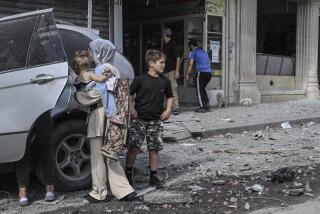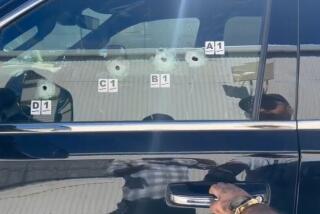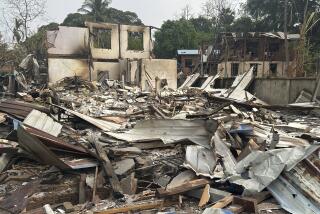For Kashmiris, Uprising Brings Fear, Pain, Deaths
- Share via
SRINAGAR, India — In the shadow of the snow-capped Himalayas, beside the tourist houseboats that ring Kashmir’s legendary Nagin Lake, Prof. Mohammed Yusuf watched in disbelief last week as Indian soldiers beat his only son.
“At least 200 of them fell on him and started beating on him with their fists and sticks,” the 70-year-old retired school principal said, his voice cracking.
“I thought he was dead. But I threw myself on him to save his head. I took two strokes on my back before they pulled me off. And then they just kept beating him and beating him and beating him until he passed out.”
And all because of four letters hand-painted on an old chinar tree just outside Yusuf’s family house--that, and his son’s defiance when the soldiers ordered him to lick each letter off with his tongue.
The letters were J.K.L.F.--the ever-present signature of the armed Jammu and Kashmir Liberation Front secessionist force. And the drama that unfolded on the banks of the lake that was once a mecca for international tourists was typical of a litany of horrors that has transformed India’s majestic northernmost state into a nightmare in paradise.
In the two months since the state government expelled foreign journalists from Jammu and Kashmir and India’s security forces launched a bloody crackdown on the Kashmiri uprising for independence, hundreds have been killed, thousands have been beaten, tens of thousands have been searched and hundreds have been jailed.
Reliable numbers are impossible to obtain. Few journalists have ventured into the embattled state since it was declared off-limits to the press.
But, for three days last week, a Times reporter quietly toured Kashmir’s war-torn capital of Srinagar by bicycle, interviewing dozens of Kashmiris, ranging from truck drivers to doctors, and witnessing the daily “cross-firings” between Kashmiri urban guerrillas and Indian troops. These clashes have left scores of civilian bystanders dead and spread panic throughout this once-idyllic Himalayan city.
The visit found a once-rich region that is suffering physically and all but dying economically. Tourism, which once provided 80% of all revenue, is non-existent. And everyone said they are living in fear--either of mukhbirs , military informants, or of moujahedeen , Islamic holy warriors from any one of half a dozen armed Kashmiri insurgent groups.
“We only have two choices now,” one prominent Kashmiri businessman said, asking not to be named. “Either you become mukhbir or moujahedeen. And, in either case, maybe you die. But, even then, almost everyone is moujahedeen now. Everyone wants independence.”
The uprising, in which Kashmir’s overwhelmingly Muslim population is demanding secession from Hindu-dominated India, has assumed grave international importance in recent weeks. India has accused its Islamic neighbor, Pakistan, of training and arming Kashmiri insurgents across the state’s international border, and Indian Prime Minister Vishwanath Pratap Singh has warned his nation to prepare for its fourth war with Pakistan in 30 years.
Fighting over the territory in 1947-48 resulted in a division of the Kashmir region, with India controlling the southern part and absorbing it as an Indian state, and Pakistan administering the northern part. Indian and Pakistani troops face each other along a cease-fire line across the region.
Even if the current conflict stops short of war, something most analysts hopefully predict, Kashmir has become a critical test case for India’s claim as the world’s largest secular democracy.
Already, Indian human rights groups have harshly condemned the army’s brutal crackdown, which is being carried out largely by Hindu troops and presided over by the state’s appointed Hindu governor, Jagmohan.
Most independent analysts in New Delhi agree that much of the
Kashmiris’ anger and frustration is well-founded--the result of decades of political manipulation and broken promises by national politicians in New Delhi, who are bound by a 1947 accord that granted the Kashmiris full autonomy in all fields except defense, communications and foreign affairs. That guarantee was the basis of Kashmir’s original decision to join India rather than Pakistan during the partition of the subcontinent.
Even several senior army officers involved in the crackdown told The Times privately that they blame the New Delhi government for failing to defuse the unrest politically before resorting to what one army general called “terribly bitter medicine.”
“The Kashmiri problem was created by the failure of the political process,” said Indian political analyst Rajni Kothari, who serves on the government planning commission and signed a recent published appeal for peace between India and Pakistan.
“The movement in Kashmir is very powerful. It’s a movement toward democracy and independence, and there is simply no wishing it away.”
Despite the Indian military campaign to force Kashmiris to remove the pro-independence and anti-Indian graffiti from the walls, trees and lampposts of Srinagar, the city remains covered with the written code of anger and secession.
“I.D.G.B.” is the most common scrawl on walls throughout the city. It stands for “Indian Dogs Go Back.”
Thousands of house-to-house searches have failed to unearth major arms caches or break the militants’ inner-city underground network.
In daylight and just yards away from Indian sentries, a reporter was taken to the home of a top leader of the Jammu and Kashmir Hezbollah Moujahedeen, the less popular pro-Pakistan faction of the two major armed groups in the militant alliance. There, with an AK-47 assault rifle that was once part of a U.S.-financed arms shipment to Afghan moujahedeen rebels at his side, the leader pledged to intensify the Kashmiri rebellion later this year by using more sophisticated weapons. These, he said, would include U.S. Stinger anti-aircraft missiles that he said the Kashmiris are buying in Pakistan.
“Until then,” he said, “we’ll continue using just grenades and small arms” to carry out daily attacks on Indian army bunkers and convoys, which he called “a catch ‘em while they’re sleeping” tactic.
Despite the presence of thousands of Indian soldiers and paramilitary forces in a city that has suffered longer under curfew than any other Indian city in recent memory, scores of Kashmiris openly greeted a passing reporter with such phrases as “those bloody Indian dogs” and “all we want is freedom.”
Everyone interviewed at length told a personal tale of torture or deprivation.
Maulvi Mohammed Hussain Turibi, the imam (preacher) at the Batamaloo Sahib Mosque in Srinagar’s old city, described how he and his son were beaten, kicked and punched by soldiers intermittently for an entire day while being forced to walk through the neighborhood, using their bare hands to cover wall slogans with cow manure.
“I had been preaching what the prophet used to say,” Turibi said when asked why he and his family were singled out. “I used to preach that we are slaves, that we should get liberated.
“But we are being terrorized now, and I feel that if I speak out again, I will again be taken and beaten.”
At a hospital, several surgeons and physicians, all of whom asked not to be named, gathered in the office of the chief surgeon and described the human toll of 15 straight days of round-the-clock curfew, followed by an intermittent curfew last week.
Diabetics and heart patients have died for lack of medicine, they said. Pregnant women delivered stillborn babies because they couldn’t reach the hospital. Children have died of acute gastroenteritis. And a continuing meningitis epidemic has claimed the lives of many others.
Conceding their support for the armed liberation movement, the doctors said they are being followed by “Indian agents.” They said that their ambulance drivers have been beaten and hospital staff members have been arrested and tortured.
“Look what this government has done,” one of the doctors said. “A bureaucrat is a suspect. An engineer is a suspect. A doctor is a suspect. A lawyer is a suspect. My god, a policeman is a suspect.
“If we are all suspects, then who is with them (the Indians)?”
Gov. Jagmohan, who was appointed by New Delhi and given almost unlimited power to resolve the Kashmiri crisis in February, insisted that his harsh strategy is working and that most of the Kashmiris are now against the militants. He denied that the movement is an uprising.
“This is not my perception,” he told two American journalists after they emerged from Srinagar’s political “underground” Friday. “My feedback is entirely different. . . . When the people meet us now, they say, ‘Thank God you saved us from these terrorists.’ ”
Rejecting the reporters’ observations that entire neighborhoods of Srinagar are still thick with liberation front flags and discounting firsthand reports of the army’s harsh campaign against the wall slogans, Jagmohan added, “There is hardly any flag of the militants flying in this city, and the slogans are no longer there on the walls. The people themselves are removing the slogans.
“All these things show there has been tremendous positive gain.”
The governor, who had enjoyed wide popular support from the Kashmiris after his first term during a less-troubled time in the 1980s, insisted that the crackdown was regrettable but necessary.
“How many people did Abraham Lincoln have to kill to preserve the American union?” Jagmohan said in justifying the Indian campaign to retain one of it most strategic border states.
“I don’t think the people are that upset by the searches and all--well, maybe some, yes--but we had no other option but to go in for this,” he said, interrupting the interview at one point to angrily tell an official of state-run television over the telephone, “Why can’t you go film in some remote areas where life is normal and show that.”
But there were no film clips of Kashmir on the state-run news that night. There was only an announcer reading from a TelePrompTer--one paramilitary soldier shot dead and three others wounded when “terrorists” opened fire on a convoy of troops in Srinagar.
The announcement was followed by a long interview with India’s home affairs minister, Mufti Mohammed Sayeed. A Muslim, Sayeed took office last November with Prime Minister Singh’s moderate, National Front coalition government, which is under increasing pressure from its coalition partner, the strongly Hindu Indian People’s Party, to continue the Kashmir crackdown.
“The National Front government is here to give the healing touch to Kashmir,” Sayeed said on the screens of thousands of TV sets throughout Srinagar on Friday night. “Kashmir is a paradise on earth. . . . Kashmir must remain a part of India. . . . India is a multi-ethnic, multicultural, multi-linguistic, multi-religious democracy. . . . Kashmir is a symbol of Indian secularism.”
In the curfew-closed neighborhoods of Srinagar, however, few felt “healed” by Minister Sayeed, and many simply laughed sardonically and switched off their sets.
“Indian dog,” said one. “Just go home.”
But the old professor, Mohammed Yusuf, whose son was nursing his many bruises and paralyzed left arm, simply sighed through his tears and said, “Now, I want to run away from this place, away from my beautiful home. They are killing people daily here. I can’t stand it. I just can’t stand it. I can’t watch my children dying one by one.”
More to Read
Sign up for Essential California
The most important California stories and recommendations in your inbox every morning.
You may occasionally receive promotional content from the Los Angeles Times.










